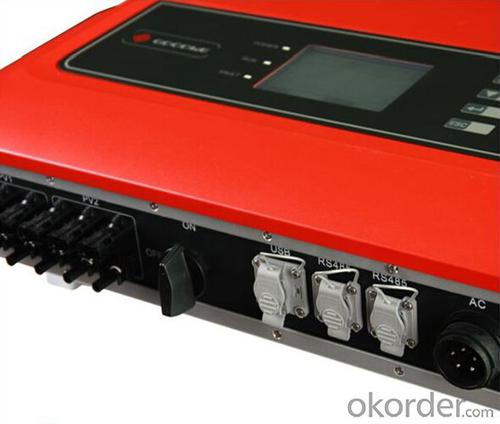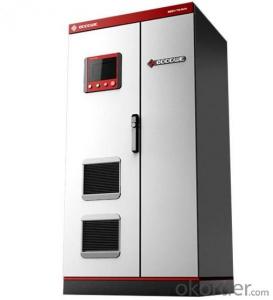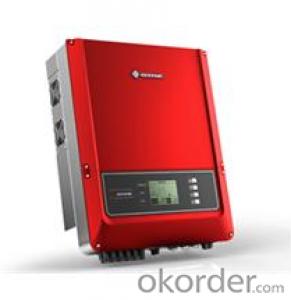110V On Grid Solar Inverter GW10K-DT
OKorder Service Pledge
OKorder Financial Service
You Might Also Like
GW10K-DT
GW10K-DT photovoltaic inverter is suitable for commercial and industrial roofs as well as small and medium-sized photovoltaic power systems. It has lower loss, more compact and lighter weight, extremely low THDi compared to similar products so that the power grid is purer.
Because of the reliable grid support capabilities, high waterproof and dustproof grade and extra-wide voltage range of module,
it can not only be used in commercial roof and commercial power station PV systems,
but also is qualified for the design requirements of large-megawatt power station.
Datasheet

- Q: What is the role of a maximum power control feature in a solar inverter?
- The role of a maximum power control feature in a solar inverter is to optimize the energy output of the solar panels by constantly tracking the maximum power point (MPP) of the solar array. This feature adjusts the operating conditions of the inverter to ensure that it operates at the highest possible efficiency, maximizing the energy harvested from the solar panels and improving overall system performance.
- Q: How does the efficiency of a solar inverter affect the overall system performance?
- The efficiency of a solar inverter plays a crucial role in the overall system performance. A higher efficiency inverter converts a greater percentage of the solar energy into usable electricity, resulting in increased energy production. This means that a more efficient inverter allows the system to generate more power, maximizing the overall performance and output of the solar system. Additionally, a higher efficiency inverter reduces energy losses, which can lead to improved system reliability and cost-effectiveness. Therefore, the efficiency of a solar inverter directly impacts the overall performance and effectiveness of the entire solar energy system.
- Q: What is the role of a maximum power point tracker in a solar inverter?
- The role of a maximum power point tracker (MPPT) in a solar inverter is to ensure that the solar panels are operating at their maximum power output. The MPPT continuously monitors the voltage and current of the solar panels and adjusts the operating conditions to find and maintain the maximum power point. This optimization helps to maximize the efficiency and overall energy generation of the solar system.
- Q: Can a solar inverter be used in a solar-powered irrigation system?
- Yes, a solar inverter can be used in a solar-powered irrigation system. A solar inverter is responsible for converting the direct current (DC) produced by solar panels into alternating current (AC), which is necessary for powering electrical devices such as pumps and motors in an irrigation system. By connecting the solar panels to a solar inverter, the energy generated by the sun can be efficiently utilized to operate the irrigation system, making it a sustainable and cost-effective solution for agricultural purposes.
- Q: How does a solar inverter handle fluctuations in solar panel output due to temperature changes?
- A solar inverter handles fluctuations in solar panel output due to temperature changes by employing a maximum power point tracking (MPPT) algorithm. This algorithm continuously monitors the output of the solar panels and adjusts the operating conditions of the inverter to extract the maximum power available. As temperature changes, the MPPT algorithm adapts the inverter's parameters to optimize the energy conversion process and ensure the highest possible efficiency. By dynamically adjusting the voltage and current levels, a solar inverter effectively mitigates the impact of temperature fluctuations on the solar panel's output.
- Q: What is the difference between a centralized and decentralized solar inverter system?
- A centralized solar inverter system has a single inverter that is responsible for converting the DC power generated by multiple solar panels into AC power for use in the building or to be fed back into the grid. In contrast, a decentralized solar inverter system has individual inverters connected to each solar panel, allowing for independent conversion of DC power into AC power. The main difference lies in the level of control and flexibility, as centralized systems typically offer more efficient power conversion but are reliant on the performance of the entire system, while decentralized systems provide greater adaptability and fault tolerance but may have slightly lower efficiency.
- Q: How does a solar inverter handle voltage dips and swells?
- A solar inverter is designed to handle voltage dips and swells by constantly monitoring the grid voltage. When a dip or swell occurs, the inverter's control system adjusts the output voltage accordingly to maintain a stable output. This is done through the use of power electronics and control algorithms that regulate the voltage and frequency of the inverter's output.
- Q: How does a hybrid solar inverter work?
- A hybrid solar inverter works by converting the direct current (DC) electricity generated by solar panels into alternating current (AC) electricity that can be used to power appliances and equipment in a home or business. It also has the ability to store excess electricity in batteries for later use. Additionally, it can draw electricity from the grid when solar power is not sufficient, ensuring a continuous power supply. Overall, a hybrid solar inverter maximizes the use of solar energy and provides flexibility in managing electricity consumption.
- Q: Are there any noise or vibration concerns associated with solar inverters?
- Yes, there can be noise and vibration concerns associated with solar inverters, although they are generally minimal. Some older or lower-quality inverters may produce a humming or buzzing sound, especially when operating at high power levels. Vibrations can also occur due to the internal components and fans. However, modern inverters are designed to minimize noise and vibrations, and most people find them to be quiet and unobtrusive.
- Q: What is the role of a solar inverter in a solar-powered electric fence?
- The role of a solar inverter in a solar-powered electric fence is to convert the direct current (DC) electricity generated by the solar panels into alternating current (AC) electricity that can be used by the electric fence system. The inverter ensures that the voltage and frequency of the electricity are compatible with the electric fence equipment, allowing it to function effectively and safely.
Send your message to us
110V On Grid Solar Inverter GW10K-DT
OKorder Service Pledge
OKorder Financial Service
Similar products
Hot products
Hot Searches
Related keywords






















